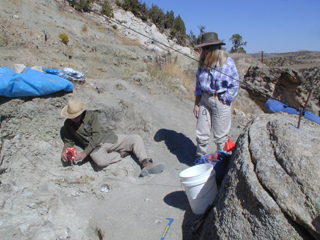 In 1993,
veterinarian and longtime amateur fossil collector Burkhard Pohl and a paleontologist
friend found dinosaur fossils at an operating cattle ranch outside of Thermopolis,
Wyo. After surveying the site, they quickly decided that there were likely more
fossils on the land than a paleontologist could recover in a lifetime. So they
created and opened the Wyoming Dinosaur Center in 1995, with a museum and pay-to-dig
program. It is now one of many “dinosaur dude ranches” that exist
throughout the Rocky Mountain West, says Brent Breithaupt, a paleontologist
and director of the University of Wyoming Geological Museum in Laramie.
In 1993,
veterinarian and longtime amateur fossil collector Burkhard Pohl and a paleontologist
friend found dinosaur fossils at an operating cattle ranch outside of Thermopolis,
Wyo. After surveying the site, they quickly decided that there were likely more
fossils on the land than a paleontologist could recover in a lifetime. So they
created and opened the Wyoming Dinosaur Center in 1995, with a museum and pay-to-dig
program. It is now one of many “dinosaur dude ranches” that exist
throughout the Rocky Mountain West, says Brent Breithaupt, a paleontologist
and director of the University of Wyoming Geological Museum in Laramie. Visitors to the Wyoming Dinosaur Center have unearthed well-preserved remnants of Diplodocus, Camarasaurus, Apatosaurus and Allosaurus fossils at the site, as well as clues to the paleoenvironment of the Late Jurassic. Courtesy of the Wyoming Dinosaur Center.
Single-day digs are great for families who have little or no experience with paleontology, Breithaupt says. On these mini-adventures, people spend a few hours “getting a good feeling for what it takes to dig up a dinosaur.” They learn that dinosaur digs are grueling and taxing, yet rewarding.
The Wyoming Dinosaur Center, which is located about two hours from Yellowstone National Park, offers single-day digs at 60 different dig sites on 500 acres of a 15,000-acre ranch. Diggers start at 8:00 a.m. with a crash course on the geology and paleontology of the area, as well as an explanation of the excavation procedures from so-called paleotechnicians (who are mostly undergraduate or graduate students). A van then carries the diggers and their guides out to dig in what Breithaupt calls “the real Jurassic Park” — the Morrison Formation, which is a sandstone, siltstone and red sandy shale formation that holds a treasure trove of dinosaur bones from the Late Jurassic. The visitors will then dig for the next six hours, stopping only for lunch and discussion about their surroundings and discoveries, big or small.
“There are many, many very important fossils still to be found,” Breithaupt says. “And any time you get someone out in the field, something big could be found.” It is entirely within the realm of possibility that a person digging on a day-dig program could unearth part of a complete skeleton, a new species or genus of dinosaur, or missing parts of a dinosaur, he says.
Indeed, over the last 10 years, approximately 6,000 visitors have participated in the digs and have found well-preserved remnants of Diplodocus, Camarasaurus, Apatosaurus and Allosaurus (the only meat-eater) fossils, as well as clues to the Jurassic environment, says David Gray, director of the Big Horn Basin Foundation, which is a nonprofit that coordinates education and research at the Wyoming Dinosaur Center’s dig sites. A geologist who is now in charge of curating the bones that are found, Gray says that he has wanted “to play with dinosaurs” since he was eight years old.
Most of the diggers are families traveling the West or to visit Yellowstone who build in a day of dinosaur digging for the kids, Pohl says, but the center also accommodates school groups and has held special student group sessions on excavation practices. The center does not impose a minimum age limit for diggers, but Pohl suggests that parents consider how mature their kids are and what they can handle before enrolling them in such an intense program.
The Dig for a Day program can be a “very good vehicle” for individuals and families to learn about paleontology and geology, Gray says. Working one-on-one with a paleotechnician and digging for dinosaur bones with their own hands is a unique activity. But the program is mutually beneficial, Gray adds, as the museum gains from the work the diggers do to uncover bones as much as the diggers benefit from the experience.
Anything diggers find at the dig site becomes the property of the Wyoming Dinosaur Center and will be used for research and to reconstruct specimens in the museum, Pohl says. But if participants uncover a major discovery, they get their names cited in scientific papers, Gray adds. That has happened a couple of times over the years, he says, “and it’s very exciting” for all involved.
Less than 100 miles northeast, Dinosaur Safaris offers a similar digging experience on 40 acres on the Morrison Formation. Oil geologist Bob Simon began offering dinosaur digs in 2000 to people ages 10 and up. He says that visitors number 50 to 60 per season, and are of all ages. At Dinosaur Safaris, diggers can do single-day or multiple-day digs in July and August, and get to go home with a remnant of their dig. As part of the dig price, people get to keep what they unearth unless it is very valuable or of scientific importance, Simon says. Teachers receive a special discount, Simon says, because “what better way [is there] to garner interest in the earth sciences than for students to be able to hold a real dinosaur bone?”
Martin Eigenberger, an education professor at the University of Wisconsin-Parkfield, participated in a dig with Dinosaur Safaris a few years ago and says that he had a great experience. The dig captures “that certain kind of excitement that only comes with a live, real-time, three-dimensional experience,” he says.
Megan Sever

